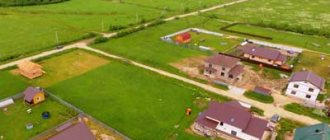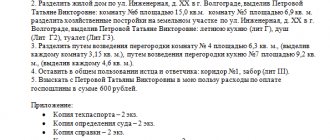Gardeners and summer residents who enter the legal field for the first time often have to think about what a plot of individual housing construction, SNT and DNP is.
The answer to this question is provided by the norms of land and construction legislation .
The main difference between the concepts is that individual housing construction is a type of permitted use of a land plot, implying the possibility of constructing a residential building on it.
SNT and DNP are forms of a legal entity , they stand for:
- SNT - gardening non-profit partnership ,
- DNP – dacha non-profit partnership .
The types of permitted use of such areas are usually the following:
- gardening,
- dacha management.
Is it possible to make a translation?
Land plots for SNT are quite inexpensive, but not all are equally suitable for living all year round. Usually houses are built on them for summer living and vegetable growing. Only garden houses can be built on such a site. And on lands for individual housing construction it is allowed to build buildings up to 3 floors for the purpose of permanent residence.
The transfer of SNT to individual housing construction is possible subject to certain formalities. It is regulated by the norms of the Land Code, the Town Planning Code and Federal Law-172 “On the transfer of land plots from one category to another.”
Important! Even if several owners own a SNT plot, it is possible to re-register the plot from one category to another.
You need to collect a package of documents and write an application.
Country construction
Only that plot of land that is allocated for personal plot farming (gardening, horticulture, livestock farming) and dacha farming is suitable for construction. According to the law, the allocated land plot of the DNP can be located both on the territory of populated areas and on agricultural lands. Ultimately, the DNP and individual housing construction plots became equivalent.
Peculiarities
The intended purpose of individual housing construction land is to expand administrative units by building a house, as well as a bathhouse, a garage, etc. SNT is a company that has its own charter, chapter and board. Therefore, members of the gardening partnership are required to account for actions performed on the land.
The main reason that forces citizens to undergo the transfer procedure is the need to obtain registration in a built house. It is almost impossible to register with SNT.
Another significant advantage of the transfer is the rise in price of land. Therefore, many people buy a plot for SNT, and then resell it as individual housing construction. The owner should know that with a change in the category of plot, the cadastral value and the amount of land tax will increase.
If SNT is transferred to the status of individual housing construction, then municipalities will be responsible for its improvement, supply of gas, heating, and electricity. After transferring to individual housing construction, the land plot can be pledged to the bank. It is also possible to build a house on it using maternal capital.
Note! After transferring SNT to individual housing construction, housing must be built within 10 years, otherwise the tax will double.
Construction must be carried out on the basis of permits obtained from the authorities. After completion of construction, additional approvals will be required for commissioning.
Provision of land plots from agricultural lands
Even before the new land code came into force, the allocation of plots related to dachas and included in the SNT took place on the basis of perpetual use rights. Subsequently, when the adopted law began to take effect, plots of this type were allowed to continue to be used by citizens, but some restrictions already appeared in their property rights.
The restriction was due to the fact that the use of the site continued throughout the life of the person to whom it was presented as ownership. Thus, after the death of a citizen, the fact of entering into an inheritance was very difficult, since the form of ownership in such areas is collective.
To be able to solve the problem of exploitation and all actions that are not carried out with such agricultural lands, since they are not actually private property, the so-called “dacha amnesty” began to operate at the federal level.
Dacha amnesty
The law that has entered into force provides for the possibility of privatization on a free basis, but in the event that a particular citizen has not yet used such a right granted to him by the state during his life.
The process of privatization of such plots itself consisted of collecting and providing the necessary documentation, the main element of which is confirmation of the right to privatization - allocation for perpetual use, inheritance, lease with the right to transfer ownership, etc.
Currently, the mechanism that provides the opportunity to register agricultural plots that are part of the property is still functioning. If during the process of transferring ownership certain problems arise, expressed in the insufficiency of the documentary base or for some reason in the refusal of government bodies to privatize the site, the citizen has the right to draw up and submit a statement of claim to the judicial authority.
Groups of types of land use for agricultural purposes
Most of these requests at the moment are due to the fact that many users of land under SNT died without taking full ownership, and therefore the legal heirs have to separately prove the possibility of privatization.
Such claims are filed in the district court, which is located in the territory related to the magistrate, and the application must be accompanied by a list of necessary documentation giving the right to apply for registration of ownership and further disposal of the site (registration of a deed of gift, purchase and sale, will, registration as collateral, etc.).
Requirements for a plot of land
- The maximum size of plots is determined by the regulations of local authorities. Each region has its own areas. On average, the minimum size of land for individual housing construction is 3 acres, the maximum is 30 acres.
- The site must be located within a city, town or settlement. None of the boundaries of the land plot should cross one of the boundaries of the neighboring plot, information about which is already contained in the State Property Committee.
- The location of all objects must strictly comply with the requirements of SNIP. The owner does not have the right to build a house, install a bathhouse or other structure wherever he wants. This also applies to planting garden trees and shrubs, the location of which must be strictly planned by state regulations.
- On an area of 1.5 thousand m2. You can build only 1 house of no more than 3 floors. Set up a garden and vegetable garden. The territory of the site must be separated by a fence no more than 0.5 meters high. When starting construction, it is necessary to retreat from the road at a distance of 5 meters and at least 3 meters if there is a passage there.
Price issue
There is no state duty for the provision of land transfer services. In this case, the applicant must pay for third-party and additional services.
- If land surveying was not carried out earlier, then the owner will have to pay 10-15 thousand rubles for this procedure.
- For a paper extract from the USRN in Rosreestr you need to pay 400 rubles. Electronic statement is not suitable. For registration of a power of attorney with a notary, about 700–1000 rubles. If there are several owners, then each of them will have to certify their consent.
- When contacting specialized legal offices, services will cost 15–45 thousand rubles. This is not counting the representation of interests in court; in the event of a refusal to transfer SNT to individual housing construction, their services can reach up to 100 thousand rubles.
On a note. When contacting specialists, the owner will not have to stand in line to receive papers. The responsibility to collect a package of documents and submit them to the administration falls entirely on the shoulders of the lawyer. In case of refusal, he is obliged to correct all existing errors.
Step-by-step instruction
We will tell you step by step how to transfer a plot of land from gardening to individual housing construction.
Preparation of documents
To transfer land to individual housing construction from SNT, you must prepare the following documents:
- Passport of the applicant(s).
- Power of attorney to represent interests.
- Technical documentation for buildings.
- Cadastral passport for land or extract from the Unified State Register of Real Estate.
- Certificate of ownership or extract from the Unified State Register.
- Consent of other owners to transfer land to another category.
Note! In some cases, a positive environmental impact assessment may be required. After collecting all the documents, they should be submitted for consideration to the local government authority.
Writing an application
In addition to the package of documents, you must submit a completed application form to the territorial administrative department. It should include the following information:
- Land rights.
- The current category of the site and the category of transfer.
- Justification for changing it, that is, proof of the legality of placing the house on the site, taking into account compliance with all sanitary, urban planning and environmental standards.
An application form is issued at the territorial administrative department and filled out according to the data available from the documents.
Submitting papers
In accordance with Federal Law No. 172, the decision to transfer one category of land to another is made by the Administration of a constituent entity of the Russian Federation. However, first of all, it will be necessary to obtain the consent of the local municipal authorities under whose jurisdiction the site is located. If the land is within the city limits, then you need to contact the city administration, if in the district, then to the district administration.
Upon receiving a positive decision, a subject of the Russian Federation can transfer SNT to individual housing construction. Only its owner has the right to submit an application. In case of shared ownership of land, personal petitions from each owner will be required.
Getting a response
The result of the review will be either a reasoned refusal or the issuance of documents on the transfer of SNT to individual housing construction. It takes at least 2 months to consider the application. After the decision is made, it is transmitted to the applicant no later than 14 days. If the outcome of the case is positive, a corresponding act is issued. In case of refusal, a written reason.
On a note. If the application is approved, the owner must contact Rosreestr to make changes. If refused, go to court to appeal.
Personal subsidiary plot
Private household plots are agricultural plots; their main difference from SNT and individual housing construction plots is their mandatory location in the fields or within the boundaries of a populated area in the form of household plots.
In the case of the field option, only the cultivation of products is allowed, and construction is prohibited. In the urban location, housing construction is provided, but taking into account the required standards. Positive aspects of operating private plots:
- the location of the plot within the city makes it possible to transfer it to the category of individual housing construction;
- taxation is carried out at preferential rates - less than 0.3% of the indicated value according to the cadastre.
Negative characteristics include:
- modern legislation omits such a formation as private household plots, so confusion arises when making transactions;
- When registering ownership of plots located on the outskirts of settlements, there is a dependence on the decision of local municipal services, which may not allow the construction of housing.
What could cause a refusal and what to do in these cases?
For a number of reasons, the applicant may receive a refusal to transfer SNT to individual housing construction in accordance with Art. 4 of Federal Law No. 172-FZ:
- Negative environmental conclusion.
- A transfer ban has been imposed on the site.
- The area is not suitable for development.
- There is no possibility of annexation to the settlement, making it impossible to make changes to the planning documents.
- The application was not submitted by the owner of the site himself.
In court, interested citizens can challenge the decision of the authorities, but in case of conflict with federal legislation, the court decides to refuse the transfer of land. Refusal is issued only in writing.
On our website you will also find interesting articles on how to transfer land to individual housing construction:
- From private household plots.
- From agricultural land.
The concept of SNT
On lands of this category, agricultural crops are grown and buildings necessary for their processing and preservation are located. It is permitted, if necessary, to erect residential buildings on the site.
Documents of a non-profit gardening partnership
The charter is adopted as the main document, in which all changes or additions are made at the general meeting of all participants. The charter contains the following provisions:
- general information and purpose of formation, the rights of the partnership as a legal entity and its responsibilities;
- the property of the partnership is transferred;
- the conditions for membership in the SNT are indicated;
- management bodies are described and the boundaries of their competence are determined;
- the control bodies, their activities and forms of control work on the redistribution of material resources are indicated;
- the ways of forming a special fund are listed;
- the boundaries of the partnership's liability for debts and the procedure for office work have been determined;
- provides for the procedure for the reorganization or liquidation of SNT.
Are there any fees for SNT members?
This question worries the new owners of plots in the formation.
The solution is found by reading the Federal Law of April 15, 1998 on the activities of vegetable gardening, dacha and horticultural societies, where Article 19 contains information on contributions. It states that all participants in partnerships and partnerships are required to pay membership fees, but the procedure for collecting them is not specified. The procedure for collecting contributions is determined by the accountant in his own way, but the amount is determined depending on the size of the plot. Each charter may provide for a one-time fee upon joining the partnership.
Positive aspects of a non-profit gardening partnership:
- the buyer pays much less money for the plot, in contrast to individual housing construction;
- clean atmosphere due to the location in the countryside;
- It is permitted to use the plot without erecting a residential building.
Cons of SNT
- the owners pay for communications to the partnership plots; this is expensive and sometimes impossible due to the distance of the main highways;
- difficulties in obtaining permanent registration due to the location outside the residential zone, and going to court brings results, but costs money and time;
- the use of land as collateral is perceived negatively by banking institutions; this practice is rarely used;
- Regardless of the size of the residential building, it is considered as a country house, which does not make it possible to receive compensation for it upon sale, since the valuation of country houses is cheap.
Land in this category is allocated in picturesque areas, so the difference in their price is determined only by the convenience of communications and roads.
Possible alternatives
SNTs are always located on agricultural land. On plots intended for various gardening works, it is possible to build houses necessary for living in the summer. To obtain registration, year-round residence, use of material capital, and obtain a loan from a bank, it is necessary to transfer SNT into individual housing construction. There are no alternative options.
Transferring land from SNT to individual housing construction is quite a troublesome task, but it can be done. Therefore, it is worth determining for yourself in advance whether the categories really need to be changed, for what and how this territory is planned to be used. Prepare a package of documents in advance and obtain detailed information about the site.
conclusions
The most hassle-free way to build housing is to use land for individual housing construction . All issues related to such construction are quickly resolved within the legal framework.
The most attractive option in terms of price for the acquisition or construction of country and country real estate - DNP, has a drawback - difficulties with registration of registration, which, however, can be solved with a certain amount of perseverance.
After reading this article, you can decide which is more suitable for your purposes: individual housing construction land or SNT.








